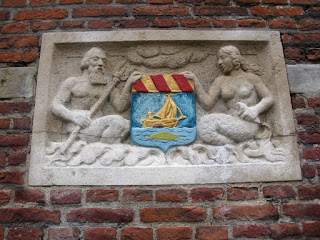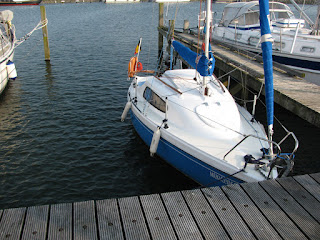Morning: Running Goose-Winged In The Sunshine
Mekicevica and crew spent the night in Hellevoetsluis, under a clear sky with a bright, full moon.
So, we made it here. But now we have 30 nm to Bruinisse, where the car is, and tomorrow is working day. The wind is still westerly, so we are going to sail downwind to the Volrerak lock and from there motor, or motor-sail as far as we can.
We motor out of the marina in a bright morning and turn west towards the Haringvliet Barrier, that separates these waters from the North Sea. Main sail up, turn down-wind, full genoa out, and we start the journey back in a very relaxing way: sunshine and wind around 3 Bf from behind us. Most of the way we were running goose-winged, only putting the genoa and the main on the same tack when the downwind line was taking us too close to either margin.
 |
| Running goose-winged on the Haringvliet. |
As every sailor knows, straight downwind is one of the most difficult points of sail and requires a lot of attention. Until now we had not really got the knack of it, but practice makes perfect, and we did the whole way back to the Haringvliet bridge mostly goose-winged and without a single accidental jibe.
Fearing the usual strange winds under the bridge, we passed it in a sort of inverted Z-trajectory, with one jibe on either side of the bridge, which took us close to the lock.
It must have been the pleasant journey and the sunshine that prevented me from murdering a skipper that we came across approaching the lock. In my opinion, he was of the most detestable kind of skipper you can come across: big, fat guy in an arrogant-looking motor yacht. As we approach the waiting pontoon he cuts us from the inside, leaving a huge wake behind. As he approaches the pontoon, his crew dropped a fender, so he starts manouvering to recover it. Not understanding his intentions, and since these types like to wait without mooring so they can be the first in, I start going between him and the peer. This provoked an irate whistle and gesticulation from Mr. Fat Arrogant Skipper. Oh, well. It is such a beautiful morning and we just had such great sailing. We just manouvered around him to the place we were going to anyway, well away from his big yacht, as these types also tend to give too much throttle and occasionally make a mess.
On the other end of the spectrum, in the lock we came alongside a motor-sailer, crewed by a very friendly couple that rushed to help with the lines and wished us a pleasant journey.
Afternoon: Motoring Into The Oude-Tongue Water-Gardens
Coming out of the lock, the first couple of miles are out of the shipping lane and the wind was such that we could hoist sails and sail on starboard tack, all on a straight line. After that we had to turn into the wind and the space between the shore and the enormously busy shipping lane got narrower and narrower. A couple of die-hards were still sailing, tacking about every two seconds. We decided to engage the services of Yo-Yo Ma. (That is our little outboard motor; the source of the name is described
in an earlier post.) The rest of the journey was much longer than his autonomy on one tank, so we stopped briefly to refuel at the small Galathese harbour (depressing place, by the way). After a while we could get out of the way of the large ships and it would have been enjoyable beating the last few miles. Except that by now it was clear we would not make it back to Bruinisse on time to ask for a mooring for the week and we had adopted plan B: try to make it to Oude-Tongue in time to catch the harbour-master before he goes home, and borrow a bicycle to go and get the car.
We had never motored for such a long stretch, and Yo-Yo Ma was starting to sound even less musical than usual. First trouble: as we were already on the channel leading to Oude-Tongue we ran out of fuel. Oh, well. At least now we know how far we can get on one tank: 4.8 nm. There was not much wind and we had a lot of sandy bottom on our lee side, so it was not a problem to refuel while slowly drifting and get back on our way.
Just past the old lock and into the narrow channel up to town, the much bigger trouble number two stroke: the water was covered with a layer of floating weeds, with long, resistant stalks. I was never good in Botany, so I can only describe them as a cross between water-cress and vines that lives floating on the water and predates on propellers of little boats. It took us forever to cover the last mile, on full power but moving painfully slow, occasionally not moving at all. Drift for a while while freeing the propeller from weeds. Repeat.
It was really embarassing to enter this very peaceful harbour with Yo-Yo Ma screeching his worst solo ever, and moving very slowly, so that each boat we passed had enough opportunity to listen.
Surprisingly, the harbour master did not send us away but was very welcoming, gave us a mooring for the week and lent us a bicycle.
We arrived home late and really tired, but already making plans for next week-end. The weather forecast is brilliant and we have just one more important goal to tick this season: the Oosterschelde and Zierikzee.


















































